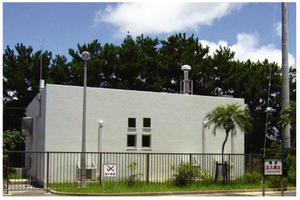Nuclear weaponsTwo suspected 2010 North Korea nuclear “tests” probably never happened: study
It is generally accepted that North Korea has carried out at least two nuclear test explosions, in 2006 and 2009, with the second test — thought to be in the range of about two to four kilotons — was five times more powerful than the first; this spring, a Swedish scientist sparked international concern when he said that radioactive particles detected in 2010 showed North Korea had set off at least two small nuclear blasts that year; now, a new paper says the tests likely never took place — or that if they did, they were too tiny to have any military significance

Radionuclide monitoring station on Okinawa // Source: jaea.go.jp
This spring, a Swedish scientist sparked international concern with a journal article saying that radioactive particles detected in 2010 showed North Korea had set off at least two small nuclear blasts — possibly in experiments designed to boost the yields of much larger bombs. Shortly after, the pot was stirred with separate claims that some intelligence agencies suspected the detonations were done in cooperation with Iran. Now, a new paper says the tests likely never took place — or that if they did, they were too tiny to have any military significance.
A release from the Earth Institute at Columbia University reports that the new report, by seismologists at Columbia University’s Lamont-Doherty Earth Observatory, will be published later this month in the journal Science & Global Security, where the earlier paper also appeared.
It is generally accepted that North Korea has carried out at least two nuclear test explosions, in 2006 and 2009. The Lamont scientists studied both those blasts via the seismic waves they generated. They concluded that the second test — thought to be in the range of about two to four kilotons — was five times more powerful than the first, though still dwarfed by the weapons of established nuclear powers (a kiloton equals the explosive energy of 1,000 tons of TNT). The suspicions of more tests in 2010 were based on whiffs of radioactive xenon and barium detected in South Korea, Japan, and Russia in May that year; but it was not until March 2012 that Lars-Erik De Geer, an atmospheric scientist with the Swedish Defense Research Agency, published the information, and suggested clandestine explosions of 50 to 200 tons as the sources. Several weeks later, a former high German defense official publicly suggested that the tests might have been done on behalf of Iran. Many experts quickly expressed skepticism, as there was no public evidence of seismic waves normally linked to such explosions; however, since then, tensions have continued to rise. In August, defense analysts warned that North Korea had made significant progress on a plant to produce highly enriched uranium, suitable for bombs. And lately, there have been increasing calls for pre-emptive attacks by the United States or Israel to keep Iran from developing a bomb.
“The recent claim of nuclear testing in 2010 has led to publicity that could be very dangerous at a time when so much belligerence
